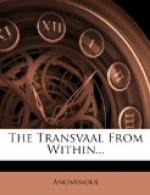By the time Sir Evelyn Wood had ranged his forces for an effective and extended attack on the Boers, and by the time Sir Frederick Roberts with the command of about 10,000 men had reached South Africa, the administration of Mr. Gladstone had awakened to the fact that the war was an unjust—not to say costly—one. An armistice was arranged and peace made without another blow.
The terms of the settlement proposed by the Liberal Government fitly illustrate the generosity of their motives. They proposed doing ‘simple justice’ to the Boers, but at the same time retaining the districts of Lydenburg, Middelburg, Wakkerstroom, and Utrecht, not to mention handing back Zoutpansberg to the original native occupants. So anxious were the Boer leaders to effect a peaceful settlement, so fearful were they of the actions of their followers, that when they arranged the long armistice they did not announce to their party the intentions of the British Government regarding the above districts. General Joubert did not communicate to his army the terms of peace, but simply stated that a Royal Commission was to settle everything. A month later, when some inkling of the terms reached the Boers, a solemn protest and warning was issued, and when the Royal Commission actually sat, the British representatives were informed that any such curtailment of the territories would be followed by a resumption of hostilities. Needless to say the proposals were abandoned and the Boers got their way. So ended the war.
Ingogo has been called a drawn battle. Bronkhorst Spruit was—such as it was. At Laing’s Nek and Majuba the Boers beat us, as Mr. Carter fairly puts it, ’when they were on the top of the hill and we were at the bottom, and when we were on the top of the hill and they were at the bottom.’ The narrative of these events is about as humiliating a one as an Englishman can read. Here and there it is redeemed by the heroic conduct of individuals in the midst of general disaster. In the smaller affairs, such as the particularly gallant defences of Standerton, Potchefstroom, and Rustenberg, where little garrisons held their own with conspicuous ability and courage, there is something to cheer the disheartened reader. The defence of Potchefstroom by Colonel Winslow should be read in full for several reasons. The siege of Standerton witnessed several acts of valour,




